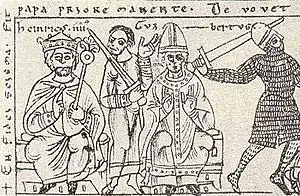1082
Year 1082 (MLXXXII) was a common year starting on Saturday (link will display the full calendar) of the Julian calendar.
| Millennium: | 2nd millennium |
|---|---|
| Centuries: | |
| Decades: | |
| Years: |
| 1082 by topic |
|---|
| Leaders |
|
| Birth and death categories |
| Births – Deaths |
| Establishments and disestablishments categories |
| Establishments – Disestablishments |
| Gregorian calendar | 1082 MLXXXII |
| Ab urbe condita | 1835 |
| Armenian calendar | 531 ԹՎ ՇԼԱ |
| Assyrian calendar | 5832 |
| Balinese saka calendar | 1003–1004 |
| Bengali calendar | 489 |
| Berber calendar | 2032 |
| English Regnal year | 16 Will. 1 – 17 Will. 1 |
| Buddhist calendar | 1626 |
| Burmese calendar | 444 |
| Byzantine calendar | 6590–6591 |
| Chinese calendar | 辛酉年 (Metal Rooster) 3778 or 3718 — to — 壬戌年 (Water Dog) 3779 or 3719 |
| Coptic calendar | 798–799 |
| Discordian calendar | 2248 |
| Ethiopian calendar | 1074–1075 |
| Hebrew calendar | 4842–4843 |
| Hindu calendars | |
| - Vikram Samvat | 1138–1139 |
| - Shaka Samvat | 1003–1004 |
| - Kali Yuga | 4182–4183 |
| Holocene calendar | 11082 |
| Igbo calendar | 82–83 |
| Iranian calendar | 460–461 |
| Islamic calendar | 474–475 |
| Japanese calendar | Eihō 2 (永保2年) |
| Javanese calendar | 986–987 |
| Julian calendar | 1082 MLXXXII |
| Korean calendar | 3415 |
| Minguo calendar | 830 before ROC 民前830年 |
| Nanakshahi calendar | −386 |
| Seleucid era | 1393/1394 AG |
| Thai solar calendar | 1624–1625 |
| Tibetan calendar | 阴金鸡年 (female Iron-Rooster) 1208 or 827 or 55 — to — 阳水狗年 (male Water-Dog) 1209 or 828 or 56 |

Emperor Henry IV (left) with Clement III.
Events
Byzantine Empire
- Spring – The Normans under Duke Robert Guiscard take Dyrrhachium (modern-day Durrës) in Illyria and advance inland, capturing most of Macedonia and Thessaly. Robert is forced to leave Greece to deal with an uprising in Italy. He leaves his son Bohemond in charge of the army, who lays siege to the city of Larissa. Emperor Alexios I mobilizes a new army, and with the support of 7,000 Seljuk Turks he clears Thessaly from the Normans.[1]
- Byzantine–Venetian treaty: Alexios I signs a trade and defence pact with Venice, in the form of an imperial Golden Bull. He grants the Venetians a commercial colony in Constantinople, as well as free trading and exemption from taxes, throughout the Byzantine Empire in return for their defense of the Adriatic Sea against the Normans.[2]
Europe
- May 12 – Battle of Mailberg: Duke Vratislaus II of Bohemia invades Austria with an army of 8,000 men (supported by mercenaries from Moravia and Bavaria). He defeats the forces under Margrave Leopold II (the Fair) near Mailberg. The northern region of Lower Austria is devastated from pillage and famine.
- December 6 – Count Ramon Berenguer II of Barcelona is killed while hunting in the woods. He is succeeded by his twin brother Berenguer Ramon II as the sole ruler of Catalonia (modern Spain).
- Winter – Emperor Henry IV leads an expedition into Italy and besieges Rome. He gains entry; a synod is agreed upon by the Romans, to rule on the dispute between Henry and Pope Gregory VII.
- Adalbero, margrave of Styria, is forced to resign in favor of his brother Ottokar II, who is an ally of Gregory VII.
- The first mention of the town of Hofgeismar (modern Germany) is recorded.
Births
- June 7 – Hui Zong, emperor of the Song Dynasty (d. 1135)
- November 11 – Ramon Berenguer III, count of Barcelona (d. 1132)
- Goswin of Anchin, French Benedictine monk and abbot (d. 1165)
- Mary of Scotland, countess of Boulogne (d. 1116)
- Minamoto no Yoshikuni, Japanese samurai (d. 1155)
- Muhammad I (Tapar), sultan of the Seljuk Empire (d. 1118)
- Petronilla of Lorraine, countess and regent of Holland (d. 1144)
- Theotonius of Coimbra, Portuguese royal advisor (d. 1162)
- Ulrich of Attems, Italian nobleman (approximate date)
- Yaropolk II Vladimirovich, Grand Prince of Kiev (d. 1139)
Deaths
- December 5 – Ramon Berenguer II, count of Barcelona
- Arsen Ninotsmindeli, Georgian bishop and calligrapher
- Bolesław II (the Generous), king of Poland (or 1081)
- David of Munktorp, English Cluniac monk and abbot
- Lothair Udo II, margrave of the Nordmark
- Waleran I (or Walram), count of Arlon and Limburg
References
- Fine, John V. A. Jr. (1991) [1983]. The Early Medieval Balkans: A Critical Survey from the Sixth to the Late Twelfth Century. Ann Arbor: University of Michigan Press. p. 282. ISBN 0-472-08149-7.
- Crowley, Roger (2012). City of Fortune: How Venice Ruled the Seas. New York: Random House. ISBN 978-1400068203.
- Yates, Nigel; Welsby, Paul A. (1996). Faith and Fabric: A History of Rochester Cathedral, 604-1994. Boydell & Brewer. p. 217. ISBN 9780851155814.
This article is issued from Wikipedia. The text is licensed under Creative Commons - Attribution - Sharealike. Additional terms may apply for the media files.